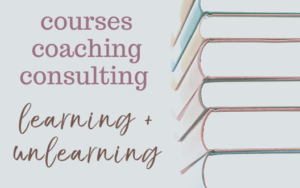What does it mean to strive for justice in everyday life? This question is front and center for me most days, but especially now, as I’m teaching two undergraduate courses focused on justice and as I’m offering a 40-day practice for a local church on “Building Resilience for Racial Justice.” These teaching spaces—the university and the church—are predominantly white and marked by whiteness that obscures understandings of race, racism, white supremacy, and systemic oppression. To uncover what’s hidden, there’s a need to slow down and examine every assumption, including what we’ve learned (or haven’t learned) about justice.
I start my course, “Writing for Social Justice,” by asking students to define “social justice”—a term we’ve heard and often use without really understanding or unpacking. Together, we cover the board with words and concepts, asking questions like:
- What’s fair?
- What’s equitable?
- What’s impactful for local and global communities?
- Who do we imagine as community members?
- Who’s centered/normalized, and who’s marginalized? And why?
- Who’s considered human, and whose humanity is undermined?
These questions become more than intellectual inquiry. They help us with processing interactions, course readings, and other texts. They help us with re-telling stories and guiding actions and everyday living.
From asking these questions and sharing our felt-sense understandings of social justice, we read Lee Anne Bell’s “Theoretical Foundations”—one of the framing articles from the excellent collection, Readings for Diversity and Social Justice.

Book cover for Readings for Diversity and Social Justice: An Anthology on Racism, Antisemitism, Sexism, Heterosexism, Ableism, and Classism.
Bell defines “social justice” as a process and a goal: both the means and the ends of achieving equitable relations. Justice includes the right to self-determination for all people and the ability for individuals to direct their lives as agents and actors. It also includes social responsibilities and interconnectedness, underscoring the importance of an equitable distribution of resources and shared participation in decision-making. Social justice, therefore, must ensure the rights of individuals, while also positioning individuals to act within larger social networks and communities. Social justice invites thinking about how we—as humans—relate with each other, with non-human animals, and with the earth, as all are interconnected and impactful.
To envision living for justice (equity, liberation, peace, full humanity), we need to understand and spend time tracking the contours of injustice (inequity, oppression, violence, dehumanization). As I’ve learned through research with co-authors (thanks especially to Rasha Diab), we must engage in BOTH the critique against injustice (problem-posing) and the critique for justice (vision-setting). Engaging in either without the other can leave us feeling frustrated or at a loss for how to respond, what to do next.
This spring I’m reminded again that it’s important to move beyond purely conceptual understandings of justice (head) and into emotional and embodied understandings (heart and hands). Using the heart-head-hands reflection prompt, I’ve been thinking with students, colleagues, and community members about how we experience systemic oppression, white supremacy, and other injustices in our everyday lives. To enact justice, we must feel into its definition, considering what opens space in our bodies and, alternatively, when our bodies intuitively constrict or send signals through pain.
There’s always more to learn, and so pursuing justice involves humility, resilience, and other emotional literacies needed for learning and un-learning. With the recognitions of (1) knowing only a little and (2) always needing to learn more, here are three of my guiding principles for pursuing justice in everyday life:
- Since justice is not only the goal but also the process, small and sustained actions matter. In the words of organizer Myles Horton: “We make the road by walking.”
- A commitment to justice needs to be “actionable” across everyday spheres of interaction: with ourselves, with others, and within institutions.
- Justice requires working against dehumanization, on the one hand, and super-humanization, on the other. To pursue justice, we must work with internalized inferiority and superiority and recognize our own and others’ humanity (and related rights to existence, self-determination, and much more).
So, what is justice? And what does it mean to strive for justice in everyday life?
Like the passing of days, answers to these questions accumulate and deepen over time. Still, it helps me to remember these guiding principles—and the teaching conversations, conceptual knowledge, and emotions that underlie them.
—
This post is written by Beth Godbee for Heart-Head-Hands.com. For more posts like this one, you might try “What I’ve Learned in the Week Since Charlottesville: Five Lessons for White Folks Who Care about Racism and Racial Justice,” “Reading Martin Luther King, Jr. as a White Woman in the Work for Racial Justice,” and “Going Public as an Educator.” Please also consider following the blog via email. Thanks!




Food! More food, please. Saw Roman Israel, Esq last night. The best part of the movie was the fact that he had written up a class action lawsuit against the legal system that denies trial by jury to so many… Then I saw a documentary on Rodriguez. Highly recommend to give his songs a shot. He had 2 albums: Cold Facts and Coming from Reality…
Sent from my iPad
>
Thanks for the recommendations! <3